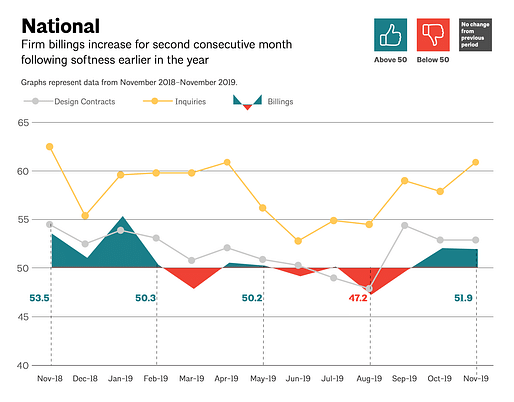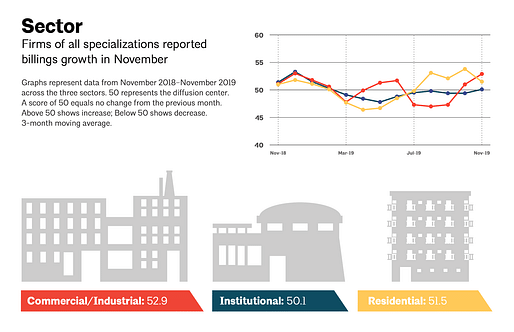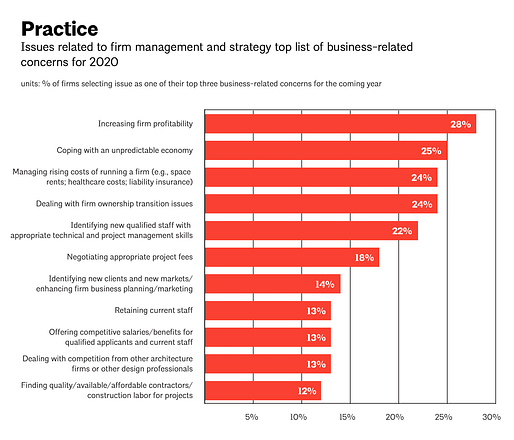

The Architecture Billings Index (ABI) registered positive growth for American architecture firms during the month of November 2019.
According to a newly published report from the American Institute of Architects (AIA), the ABI scored at 51.9 last month, signaling the second month of modest growth for the industry following a somewhat depressed summer. According to the diffusion index, which measures work-on-the-boards at various architecture firms via a voluntary survey, billings, design contract executions, and new work inquiries were all up in November.
Not only that, but three of the nation's four regional markets showed signs of positive growth, as well. In terms of the regional breakdown, the Midwest (51.1), West (51.3), and South (54.5) regions all saw increased design activity last month, while the Northeast (47.5) saw a drop in design activity. The West and South regions have shown growth consistently over the year, with the Midwest area waffling back and forth between slight gains and sharp contractions over the year. The Northeast sector has shown lagging growth all year long.
A report highlighting the overall ABI findings strikes a positive note itself, stating, "although some firms continue to report a softening in their billings, the overall picture is one of at least modest growth continuing into the near future."

The report includes a sector-by-sector breakdown of project types, with all sectors showing growth in November.
Here, Commercial/Industrial (52.9) surged while Residential (51.5) and Institutional (50.1) projects showed slight increases, as well. For the year, Commercial/Industrial has been up and down, likely in response to the flare ups in President Trump's ongoing, but perhaps dissipating, international trade disputes with China and the European Union. Institutional building has oscillated between slight losses and slight gains after a relatively strong 2018. After falling steeply during the early part of the year, the Residential sector has recovered over the last six months and has powered billings growth in the South and West regions.

As it does every December, the AIA asked participating firms to identify their top three business-related concerns for the coming year. The results highlight some surprising issues.
In a sharp reversal from 2018's survey—when staff retention concerns were highest on their lists—economic concerns are a top issue this year, with 28% of firms highlighting increasing their profitability as a key concern and 25% worried over being able to cope with an unpredictable economy. After a year of recession warnings and trade war-fueled economic uncertainty and variability, this makes a lot of sense.
Firm leaders are also, however, concerned with several meat-and-potatoes issues in the office itself, with 24% of respondents stating that managing the rising costs of running a firm and dealing with firm ownership transition issues are key concerns. It could be that an increase in the number of mergers and larger firms overall—the share of firms with 50 or more employees has doubled since 2011—over the last few years is fueling operational and ownership concerns for smaller firms and among principals who are nearing retirement.
Staff-related issues like retaining current staff and offering competitive salaries and benefits ranked relatively lower on the list of concerns, with only 13% of firms highlighting these issues.
Overall, 2019 was positive for the architecture industry, with the economy and building sector showing modest growth on balance for the year, both in terms of billings and employment. Uneven growth and patchy losses have muddied the picture for the industry heading into 2020, though modest growth is projected at least for the short term.
No Comments
Block this user
Are you sure you want to block this user and hide all related comments throughout the site?
Archinect
This is your first comment on Archinect. Your comment will be visible once approved.